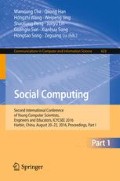Abstract
Mining important nodes in the complex network should not only consider the core nodes, but also consider the locations of the nodes in the network. Despite many researches on discovering important nodes, the importance of nodes in the structural holes is still ignored easily. Therefore, this paper proposes a method of local centrality measurement based on structural holes, which evaluates the nodes importance both by direct and indirect constraints caused by the lack of structural holes around the nodes. In this method, the attributes and locations of the nodes and their first-order and second-order neighbors are taken into account simultaneously. Deliberate attack simulation is carried out through selective deletion in a certain proportion of network nodes. Calculating the decreased ratio of network efficiency is to quantitatively describe the importance of nodes in before-and-after attacks. Experiments indicate that this method has more advantages to mine important nodes compared to clustering coefficient and k-shell decomposition method. And it is suitable for the quantitative analysis of the nodes importance in large scale networks.
Access this chapter
Tax calculation will be finalised at checkout
Purchases are for personal use only
References
Watts, D., Strogatz, S.: Collective dynamics of small world networks. Nature 393, 440–442 (1998)
Barabási, A., Bonabeau, E.: Scale free networks. Sci. Am. 288, 60–69 (2003)
Bonacich, P.: Factoring and weighting approaches to status scores and clique identification. J. Math. Sociol. 2(1), 113–120 (1972)
Freeman, L.C.: Centrality in social networks conceptual clarification. Soc. Netw. 1(3), 215–239 (1979)
Yan, G., Zhou, T., Hu, B., et al.: Efficient routing on complex networks. Phys. Rev. E 73, 046108 (2006)
Katz, L.: A new status index derived from sociometric analysis. Psychometrika 18(1), 39–43 (1953)
Kitsak, M., Gallos, L.K., Havlin, S., et al.: Identification of influential spreaders in complex networks. Nat. Phys. 6, 888–893 (2010)
Brin, S., Page, L.: The anatomy of a large-scale hypertextual web search engine. In: Seventh International World-Wide Web Conference, vol. 30, pp. 107–117 (1998)
Lü, L., Zhang, Y.C., Yeung, C.H., et al.: Leaders in social networks, the delicious case. PLoS ONE 6, e21202 (2011)
Granovetter, M.S.: The strength of weak ties. Am. J. Sociol. 78(6), 1360–1380 (1973)
Coleman, J.S.: Social capital in the creation of human capital. Am. J. Sociol. 94, 95–120 (1988)
Burt, R.S.: Structural Holes: The Social Structure of Competition. Harvard University Press, Boston (1992)
Burt, R.S.: Secondhand brokerage: Evidence on the importance of local structure for managers, bankers and analysts. Acad. Manag. J. 50(1), 119–148 (2007)
Vragovic, I., Louis, E., Díaz, A.: Efficiency of informational transfer in regular and complex networks. Phys. Rev. E 71, 036122 (2005)
Ren, Z.M., Shao, F.L., Jian, G., et al.: Node importance measurement based on the degree and clustering coefficient information. Acta Phys. Sin. 62(12), 128901 (2013)
Lusseau, D., Schneider, K., Boisseau, O.J., et al.: Behav. Ecol. Sociobiol. 54, 396–405 (2003)
Girvan, M., Newman, M.E.J.: Community structure in social and biological networks. Proc. Natl. Acad. Sci. USA 99(12), 7821–7826 (2002)
White, J.G., Southgate, E., Thompson, J.N., Brenner, S.: Phil. Trans. R. Soc. Lond. 314, 1–340 (1986)
Ren, X.L., Lü, L.Y.: Review of ranking nodes in complex networks. Chin. Sci. Bull. (Chin. Ver.) 59, 1175–1197 (2014). (in Chinese)
Chen, D.B., Lü, L., Shang, M.S., et al.: Identifying influential nodes in complex networks. Physica A 391(4), 1777–1787 (2012)
Stephenson, K., Zelen, M.: Rethinking centrality: methods and examples. Soc. Netw. 11(1), 1–37 (1989)
Brandes, U.: A faster algorithm for betweenness centrality. J. Math. Sociol. 25, 163–177 (2001)
Zhou, T., Liu, J.G., Wang, B.H.: Notes on the algorithm for calculating betweenness. Chin. Phys. Lett. 23(8), 2327 (2006)
Estrada, E., Hatano, N.: Communicability in complex networks. Phys. Rev. E 77(3), 036111 (2008)
Newman, M.E.J.: A measure of betweenness centrality based on random walks. Soc. Netw. 27, 39–54 (2005)
Estrada, E., Rodriguez, J.A.V.: Subgraph centrality in complex networks. Phys. Rev. E 71, 056103 (2005)
Bonacich, P.: Factoring and weighting approaches to status scores and clique identification. J. Math. Sociol. 2(1) (1972)
Poulin, R., Boily, M.C., Mâsse, B.: Dynamical systems to define centrality in social networks. Soc. Netw. 22(3), 187–220 (2000)
Kleinberg, J.M.: Authoritative sources in a hyperlinked environment. J. ACM (JACM) 46(5), 604–632 (1999)
Chakrabarti, S., Dom, B., Raghavan, P., et al.: Automatic resource compilation by analyzing hyperlink structure and associated text. Comput. Netw. ISDN Syst. 30(1–7), 65–74 (1998)
Lempel, R., Moran, S.: The stochastic approach for link-structure analysis (SALSA) and the TKC effect. Comput. Netw. 33(1–6), 387–401 (2000)
Han, Z.M., Wu, Y., Tan, S.X., et al.: Ranking key nodes in complex networks by considering structural holes. Acta Phys. Sin. 64(5), 058902, 1–9 (2015)
Acknowledgments
The work was supported by The National Natural Science Foundation of China (Nos. 61402126, 61073043, 61370083).
Author information
Authors and Affiliations
Corresponding author
Editor information
Editors and Affiliations
Rights and permissions
Copyright information
© 2016 Springer Science+Business Media Singapore
About this paper
Cite this paper
Xu, H., Zhang, J., Yang, J., Lun, L. (2016). Measurement of Nodes Importance for Complex Networks Structural-Holes-Oriented. In: Che, W., et al. Social Computing. ICYCSEE 2016. Communications in Computer and Information Science, vol 623. Springer, Singapore. https://doi.org/10.1007/978-981-10-2053-7_41
Download citation
DOI: https://doi.org/10.1007/978-981-10-2053-7_41
Published:
Publisher Name: Springer, Singapore
Print ISBN: 978-981-10-2052-0
Online ISBN: 978-981-10-2053-7
eBook Packages: Computer ScienceComputer Science (R0)

